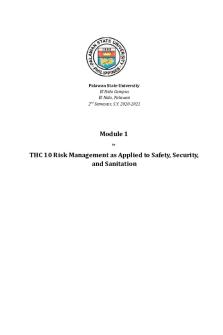4. Risk Analysis and Management PDF

| Title | 4. Risk Analysis and Management |
|---|---|
| Course | Project Management |
| Institution | The University of Warwick |
| Pages | 3 |
| File Size | 230.6 KB |
| File Type | |
| Total Downloads | 322 |
| Total Views | 594 |
Summary
Project Management Risk Analysis and Management What is Risk? “the perceived risk of an activity is a linear function of five dimensions: its probability of harm, benefit, status quo and its expected harm and benefit” “expected harm and benefit measure the perceived magnitudes of negative and po...
Description
Project Management Risk Analysis and Management What is Risk? “the perceived risk of an activity is a linear function of five dimensions: its probability of harm, benefit, status quo and its expected harm and benefit” “expected harm and benefit measure the perceived magnitudes of negative and positive outcomes, whereas the probability of harm and benefit measure the perceived probability of negative and positive outcomes occurring” “the probability of status quo measures the probability of breaking even as a result of engaging in an activity” What is Risk Analysis?
Why Analyse Risk? “the objective of the risk analysis is to enable the project manager to include contingencies, that is, having identified the most risky elements of the project, to put some actions in place to make sure that the risk is minimized” (Maylor 2010:230) How can Risk be Managed? (Maylor 2010) Identify, quantify and solve or prepare for the problem before it happens
Project Management
Outsource so the contractor deals with the risk Try it out first in a trial or pilot
What Qualitative Approaches can we Use? Probability Impact Chart
Failure Mode Effect Analysis (FMEA) o (likelihood) x (severity) x (hideability) o In other words: (probability) x (impact) x (how easy for someone to hide problem from rest of project team until its too late?) Expected Value o Expected Value = possible outcome c probability of its occurrence Programme Evaluation & Review Technique (PERT) o Optimistic time = o o Most likely time = m o Pessimistic time = p
o Expected time = [o + 4m +p]/6 o Variance of activity time = [[p-o]/6]2
Project Management
Sensitivity Analysis
Monte Carlo Simulation o Uses ranges of values for time, cost and other estimates finances and other critical project factors...
Similar Free PDFs

4. Risk Analysis and Management
- 3 Pages

Lecture 4: Risk Management
- 3 Pages

Risk Management
- 36 Pages

Risk Management Plan Assignment
- 25 Pages

Tim Horton’s Risk Management
- 4 Pages

Risk Management Modules
- 24 Pages

Risk Management Guidelines SBP
- 42 Pages

Risk Management During Design
- 28 Pages
Popular Institutions
- Tinajero National High School - Annex
- Politeknik Caltex Riau
- Yokohama City University
- SGT University
- University of Al-Qadisiyah
- Divine Word College of Vigan
- Techniek College Rotterdam
- Universidade de Santiago
- Universiti Teknologi MARA Cawangan Johor Kampus Pasir Gudang
- Poltekkes Kemenkes Yogyakarta
- Baguio City National High School
- Colegio san marcos
- preparatoria uno
- Centro de Bachillerato Tecnológico Industrial y de Servicios No. 107
- Dalian Maritime University
- Quang Trung Secondary School
- Colegio Tecnológico en Informática
- Corporación Regional de Educación Superior
- Grupo CEDVA
- Dar Al Uloom University
- Centro de Estudios Preuniversitarios de la Universidad Nacional de Ingeniería
- 上智大学
- Aakash International School, Nuna Majara
- San Felipe Neri Catholic School
- Kang Chiao International School - New Taipei City
- Misamis Occidental National High School
- Institución Educativa Escuela Normal Juan Ladrilleros
- Kolehiyo ng Pantukan
- Batanes State College
- Instituto Continental
- Sekolah Menengah Kejuruan Kesehatan Kaltara (Tarakan)
- Colegio de La Inmaculada Concepcion - Cebu







